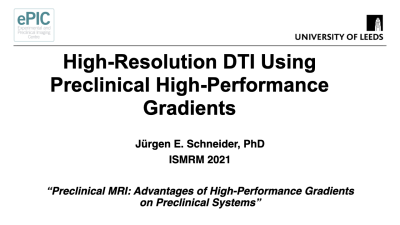Sunrise Session
Preclinical MRI: Advantages of High-Performance Gradients on Preclinical Systems
ISMRM & SMRT Annual Meeting • 15-20 May 2021

| Concurrent 7 | 16:00 - 17:00 | Moderators: Yen-Yu Ian Shih |
| Diffusion MR: Advantages of High-Performance Gradients
Junzhong Xu
To probe more comprehensive microstructural information in biological tissues, higher q values or shorter diffusion times are two strategies that are usually used. These in turn require stronger gradient strength and/or faster slew rate, which are provided by high-performance gradient systems. This education talk first covers the basics of diffusion MRI why high-performance gradients are essential for diffusion research, then provides example applications of how high-performance gradients extend the ability of diffusion MRI to probe microstructural information and last provides some technical consideration of high-performance gradients in practice.
|
||
 |
High-Resolution DTI Using Preclinical High-Performance Gradients
Jürgen Schneider
Diffusion MRI is a non-invasive method to interrogate the micro-structure of tissue in humans and animal models alike. Diffusion Tensor Imaging (DTI) is the most common applied technique in this context and can be used to quantify the amount and the directionality of water diffusion in the tissue. Diffusion contrast is typically achieved by means of pulsed magnetic field gradients. This educational lecture will briefly review the basics of diffusion MRI and focus on discussing the role and benefits of high-performance gradient systems for microstructural investigations of brain and heart in the preclinical setting.
|
The International Society for Magnetic Resonance in Medicine is accredited by the Accreditation Council for Continuing Medical Education to provide continuing medical education for physicians.